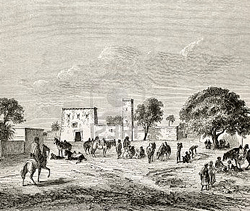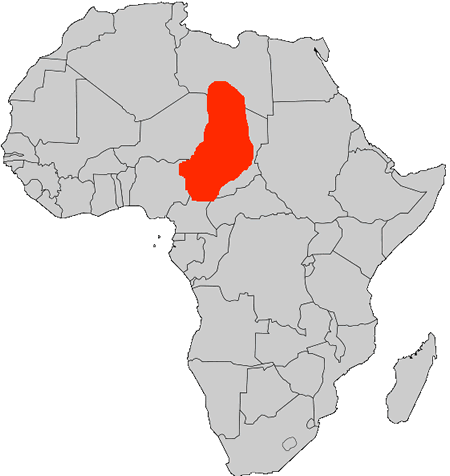World History
By 1200 c.e. the earlier African kingdoms of Ghana, Mali, and Songhai had passed. The dominant power in western Africa was Kanem Bornu. Another term for this region, since it encompasses part of central Africa, is Sudanic Africa. The first major leader of these kingdoms was Hummay, the diwan or mais of Kanem Bornu. (The term diwan attests to the Islamic and Arab influence since later on in the Ottoman Turkish Empire, diwan or divan came to mean the seat of government.)
Hummay ruled around 1075 and marked the appearance of Islam as a major force. In Africa as in Southeast Asia, particularly Indonesia, Islam was fostered as much by traders and wandering imams, or clerics, as it was by holy war, or jihads of conquest.
Living in a semiarid region, trade, as seen in the use of vast caravans, was the way to wealth, since agriculture in this forbidding climate was a challenge at best. Therefore Hummay, and the following kings of his Sefuwa dynasty, carried on a protracted struggle to gain control of the caravans and trade routes from their capital at Njimi, northeast of Lake Chad.
Of course, waterborne trade on the lake was also an object of their mercantile ambitions. Trade in gold grew to become a major source of wealth—and conflict—in the entire region. It was first spurred by Arab traders, who shipped it to North Africa, where a mint to make dinars had been opened in Kairouan in today’s Tunisia.
Later, as John Reader wrote in Africa: The Biography of the Continent, “the trans-Saharan trade [in gold] was further boosted when Europe began minting gold coins for the first time since the disintegration of the Roman empire†in the 13th century.
During their struggles for trade, the Sefuwa kings, especially in the region of the Fezzan, in what is now southern Libya, came into conflict with the Berber warriors from the Sahara. However while pursuing trade, the rulers of Kanem Bornu also realized that making alliances with more sedentary, agricultural peoples would provide them with a steady source of food and thus kept good relations with the farming peoples of the Lake Chad region.
 Another source of wealth for the Sefuwa kings was in the form of slavery, which under them became a major part of their economy. The height of the power of Kanem Bornu came in the reign of Hummay’s descendant Dunawa Dibilani (r. 1210–48).
Another source of wealth for the Sefuwa kings was in the form of slavery, which under them became a major part of their economy. The height of the power of Kanem Bornu came in the reign of Hummay’s descendant Dunawa Dibilani (r. 1210–48).
There had been a diluting of Islamic influence in the decades following Hummay, and Dunawa set about restoring Islam. He also carried out a series of jihads between the Fezzan and Lake Chad, which not only increased the power of the kingdom, but also provided him with a lucrative income from the sale of slaves in the Muslim markets to the north.
The death of Dunawa brought with it nearly two centuries of internal unrest and external invasions, at the same time as the Hausa peoples from what is now Nigeria attempted to expand their territory in the same general region. Ali Gaji (c. 1497–1515) finally succeeded in establishing the old Kanem Bornu kingdom again, with a new capital at Ngazargamu. The kingdom would flourish for nearly 300 more years until, as the Hausas, it fell under the power of the imperialistic Fulanis.
- Kingdoms Of Gold And Salt
Kingdoms of Gold and Salt For those who knew how to survive it, the Sahara was not an impenetrable desert as much as it was a vast, navigable ocean. Like ships on the ocean, large camel caravans have crossed vast distances on waves of sand for centuries,...
- Sunni Ali - Founder Of West African Songhai Dynasty
Sunni Ali Sunni Ali was an African ruler who founded the Songhai Empire in the 15th century. He was the hereditary ruler of the kingdom of Songhai, which existed from the 11th century and was centered in the city of Gao on the Niger River in the southeastern...
- History Of Nigeria
History of Nigeria. This is a short essay on the history of the African nation of Nigeria. Yes, there is more to this nation than e-mail scams! The Encyclopædia Britannica notes, "Country located on the coast of western Africa. It has an area of 356,669...
- History Of Chad
History of Chad. This is a short but interesting overview to the history of the African nation of Chad. From the site: Chad has a long and rich history. A humanoid skull found in Borkou is more than 3 million years old. Because in ancient times...
- History Of Central African Republic
History of Central African Republic. This is a good overview to the history of this African nation. The major emphasis is on recent history. From the site: The C.A.R. appears to have been settled from at least the 7th century on by overlapping...
World History
Kanem Bornu
 |
| Kanem Bornu map |
By 1200 c.e. the earlier African kingdoms of Ghana, Mali, and Songhai had passed. The dominant power in western Africa was Kanem Bornu. Another term for this region, since it encompasses part of central Africa, is Sudanic Africa. The first major leader of these kingdoms was Hummay, the diwan or mais of Kanem Bornu. (The term diwan attests to the Islamic and Arab influence since later on in the Ottoman Turkish Empire, diwan or divan came to mean the seat of government.)
Hummay ruled around 1075 and marked the appearance of Islam as a major force. In Africa as in Southeast Asia, particularly Indonesia, Islam was fostered as much by traders and wandering imams, or clerics, as it was by holy war, or jihads of conquest.
Living in a semiarid region, trade, as seen in the use of vast caravans, was the way to wealth, since agriculture in this forbidding climate was a challenge at best. Therefore Hummay, and the following kings of his Sefuwa dynasty, carried on a protracted struggle to gain control of the caravans and trade routes from their capital at Njimi, northeast of Lake Chad.
  |   |
Of course, waterborne trade on the lake was also an object of their mercantile ambitions. Trade in gold grew to become a major source of wealth—and conflict—in the entire region. It was first spurred by Arab traders, who shipped it to North Africa, where a mint to make dinars had been opened in Kairouan in today’s Tunisia.
Later, as John Reader wrote in Africa: The Biography of the Continent, “the trans-Saharan trade [in gold] was further boosted when Europe began minting gold coins for the first time since the disintegration of the Roman empire†in the 13th century.
During their struggles for trade, the Sefuwa kings, especially in the region of the Fezzan, in what is now southern Libya, came into conflict with the Berber warriors from the Sahara. However while pursuing trade, the rulers of Kanem Bornu also realized that making alliances with more sedentary, agricultural peoples would provide them with a steady source of food and thus kept good relations with the farming peoples of the Lake Chad region.

There had been a diluting of Islamic influence in the decades following Hummay, and Dunawa set about restoring Islam. He also carried out a series of jihads between the Fezzan and Lake Chad, which not only increased the power of the kingdom, but also provided him with a lucrative income from the sale of slaves in the Muslim markets to the north.
The death of Dunawa brought with it nearly two centuries of internal unrest and external invasions, at the same time as the Hausa peoples from what is now Nigeria attempted to expand their territory in the same general region. Ali Gaji (c. 1497–1515) finally succeeded in establishing the old Kanem Bornu kingdom again, with a new capital at Ngazargamu. The kingdom would flourish for nearly 300 more years until, as the Hausas, it fell under the power of the imperialistic Fulanis.
- Kingdoms Of Gold And Salt
Kingdoms of Gold and Salt For those who knew how to survive it, the Sahara was not an impenetrable desert as much as it was a vast, navigable ocean. Like ships on the ocean, large camel caravans have crossed vast distances on waves of sand for centuries,...
- Sunni Ali - Founder Of West African Songhai Dynasty
Sunni Ali Sunni Ali was an African ruler who founded the Songhai Empire in the 15th century. He was the hereditary ruler of the kingdom of Songhai, which existed from the 11th century and was centered in the city of Gao on the Niger River in the southeastern...
- History Of Nigeria
History of Nigeria. This is a short essay on the history of the African nation of Nigeria. Yes, there is more to this nation than e-mail scams! The Encyclopædia Britannica notes, "Country located on the coast of western Africa. It has an area of 356,669...
- History Of Chad
History of Chad. This is a short but interesting overview to the history of the African nation of Chad. From the site: Chad has a long and rich history. A humanoid skull found in Borkou is more than 3 million years old. Because in ancient times...
- History Of Central African Republic
History of Central African Republic. This is a good overview to the history of this African nation. The major emphasis is on recent history. From the site: The C.A.R. appears to have been settled from at least the 7th century on by overlapping...
